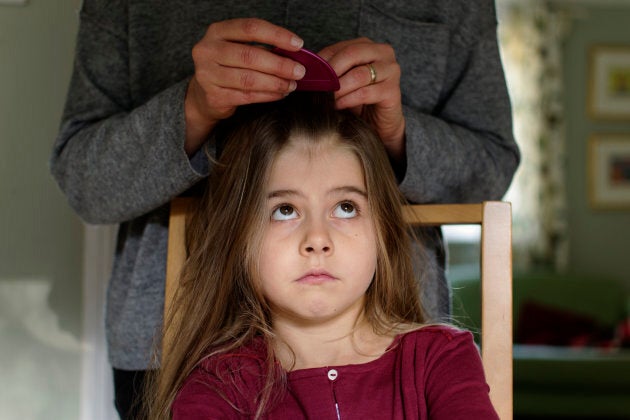
'Twas the night before Christmas, when all through the house, all the parents were combing their own hair for louse.
The stockings were thrown on the fire with care, in case any creatures had been lurking there.The children were nestled on sheet-less, bare beds, while tiny gross parasites danced on their heads. And Mama burned her kerchief, and I burned my cap, and we collapsed on the floor and we asked "what the crap?"
We could go on, but we think you get our point: lice. are. the. worst. thing. ever.
And now experts are warning that the holidays provide a rife opportunity for head lice to spread thanks to... family photos. Yes, gathering in close to take a photo for this year's Christmas card or getting the kids to lean in for a selfie with grandma could give lice the opportunity to crawl from one scalp to another, according to a Facebook post from lice-removal service Ottawa Lice Squad.
"The holidays are a time of celebration and unity! We embrace our friends and family for smiling group photos and impromptu selfies," Ottawa Lice Squad wrote in a Dec. 6 post.
"But holding our loved ones close can introduce a risk: head lice! These tiny crawlers travel from scalp to scalp to find new hosts. An entire family can find themselves infested after an evening of merry fun."
It's not the first time photos have been cited as a lice risk. In 2015, researchers warned that selfie culture was causing an increase in the creepy crawlers because people were touching their heads together for photos.
No big deal.
All about lice
Head lice are tiny, wingless, blood-sucking insects that live on the human scalp and lay eggs, and are very common in school-age children and children in childcare, according to the Canadian Paediatric Society (CPS).
The Centers for Disease Control and Prevention estimates that 6 to 12 million infestations occur each year among children ages three to 11 in the United States.
They spread by hair-to-hair contact or by sharing hats, combs, hairbrushes and headphones, CPS says. The most common sign of head lice is an itchy scalp. When you look closely at your kid's (or your own) scalp, you'll see nits (lice eggs), which are "white-ish grey, tan or yellow ovals about the size of a grain of sand" that stick to the hair, close to the scalp, CPS says.
And you might also see some young or adult lice scurrying around in there, but those are harder to spot since they move so quickly.

"You may just see movement rather than the actual lice. Lice are usually found very close to the scalp, at the bottom of the neck and behind the ears," CPS said.
Lice can be treated using drugstore insecticides, and all items that come in contact with an infected person's head should be washed in hot water and put in the dryer for at least 15 minutes, CPS said.
"Having head lice does not mean you are not clean," CPS noted.
So. At least there's that.
Holiday risks
It's not just photos that pose a risk, Ottawa Lice Squad said on Facebook. Sharing a bed or personal items with visiting friends or cousins is another way for lice to spread.
"The togetherness of cousins and pals makes the holidays special, but it also can be a gamble," Ottawa Lice Squad said.

They recommend that parents have a talk with their kids about "selfie safety," and remind them to keep their distance in photos. If your child is attending a sleepover, send them with their own hairbrush and other personal items, Ottawa Lice Squad said. And be sure to check your child's scalp after all get-togethers and holiday parties.
And hey, just in case we haven't ruined Christmas for you yet, there's also this: live Christmas trees can be infested with something called "bark lice."
Sorry.
Also on HuffPost: